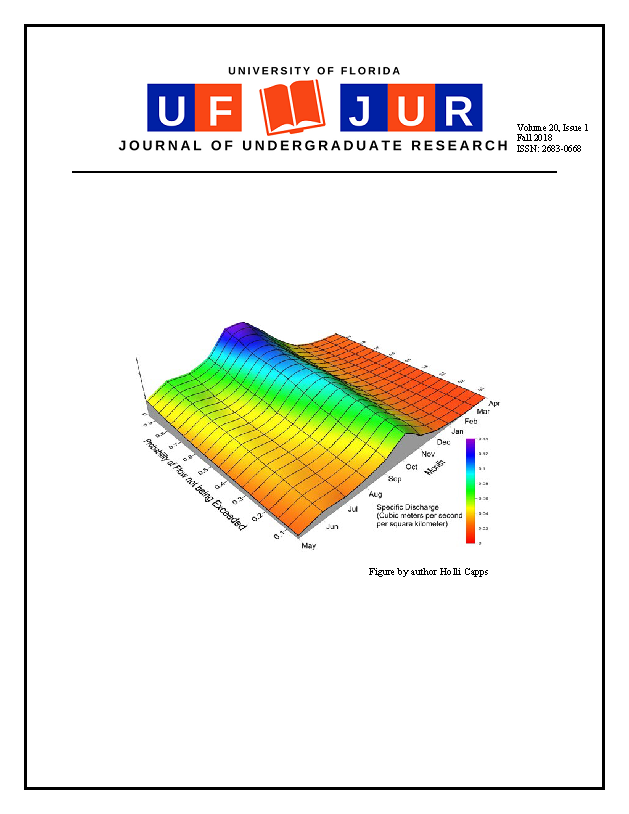Comparing Harvest Productivity of the Filamentous Alga Oedogonium with Microalgae
DOI:
https://doi.org/10.32473/ufjur.v20i1.106221Keywords:
algae, oedogonium, bioenergy, filamentous, carbon dioxideAbstract
As the planet is faced with depletion of its natural resources, alternative and sustainable energy sources are becoming increasingly sought after. Research on the growth of algae has revealed their potential for carbon capture to reduce greenhouse gas emissions and for conversion into a fuel source for bioenergy applications. Filamentous algae have attracted recent attention as an optimal species due to their ease of harvest and dominance over other species. To determine the most suitable species for future biomass applications, a 1000-L open raceway pond was inoculated with the freshwater filamentous alga, Oedogonium. The pond culture was harvested weekly to determine the effects of CO2 addition on culture density (mg VSS/L) and harvest productivity (g VSS/m2-day). An additional two 1000-L raceway ponds with established cultures of microalgae already receiving CO2 were used as a comparison to the growth of Oedogonium. After 3 weeks, Oedogonium harvest productivity exceeded both microalgal ponds at 13.7 (± 0.2) g VSS/m2-day compared to 9.3 (± 0.7) and 9.5 (± 0.3) g VSS/m2-day for the microalgae.
Metrics
References
APHA (2012). Standard Methods for the Examination of Water and Wastewater, 22nd ed. American Public Health Association/ American Water Works Association/Water Environment Federation, Washington, DC.
Choo, K., Snoeijs, P. and Pedersen, M. (2008). Uptake of inorganic carbon by Cladophora glomerata (Chlorophyta) from the Baltic Sea. Journal of Phycology, 38(3), 493-502. doi: 10.1046/j.1529-8817.2002.01083.x
Cole, A.J., Mata, L., Paul, N.A. and de Nys, R. (2014). Using CO2 to enhance carbon capture and biomass applications of freshwater macroalgae. GCB Bioenergy, 6(6), 637-645. doi: 10.1111/gcbb.12097
Florida Automated Weather Network (2018). Retrieved April 16, 2018, from http://fawn.ifas.ufl.edu/data/reports/
Lawton, R.J., de Nys, R. and Paul, N.A. (2013). Selecting reliable and robust freshwater macroalgae for biomass applications. PLoS ONE, 8(5), e64168. doi: 10.1371/journal.pone.0064168
Lawton, R.J., de Nys, R., Skinner, S. and Paul, N.A. (2014). Isolation and identification of Oedogonium species and strains for biomass applications. PLoS ONE, 9(3), e90223. doi: 10.1371/journal.pone.0090223
Molina Grima, E., Belarbi, E.H., Acién Fernández, F.G., Robles Medina, A. and Chisti, Y. (2003). Recovery of microalgal biomass and metabolites: process options and economics. Biotechnology Advances, 20(7-8), 491-515. doi:
1016/S0734-9750(02)00050-2
Roberts, D.A., de Nys, R. and Paul, N.A. (2013). The effect of CO2 on algal growth in industrial waste water for bioenergy and bioremediation applications. PLoS ONE, 8(11), e81631. doi: 10.1371/journal.pone.0081631
Singh, D., Croiset, E., Douglas, P.L. and Douglas, M.A. (2003). Techno-economic study of CO2 capture from an existing coal- fired power plant: MEA scrubbing vs. O2/CO2 recycle combustion. Energy Conversion and Management, 44(19), 3073-3091. doi: 10.1016/S0196-8904(03)00040-2
Spolaore, P., Joannis-Cassan, C., Duran, E. and Isambert, A. (2006). Commercial applications of microalgae. Journal of Bioscience and Bioengineering, 101(2), 87-96. doi: 10.1263/jbb.101.87
Wilkie, A.C., Edmundson, S.J. and Duncan, J.G. (2011). Indigenous algae for local bioresource production: Phycoprospecting. Energy for Sustainable Development, 15(4), 365-371. doi: 10.1016/j.esd.2011.07.010
Downloads
Published
Issue
Section
License
Some journals stipulate that submitted articles cannot be under consideration for publication or published in another journal. The student-author and mentor have the option of determining which journal the paper will be submitted to first. UF JUR accepts papers that have been published in other journals or might be published in the future. It is the responsibility of the student-author and mentor to determine whether another journal will accept a paper that has been published in UF JUR.

